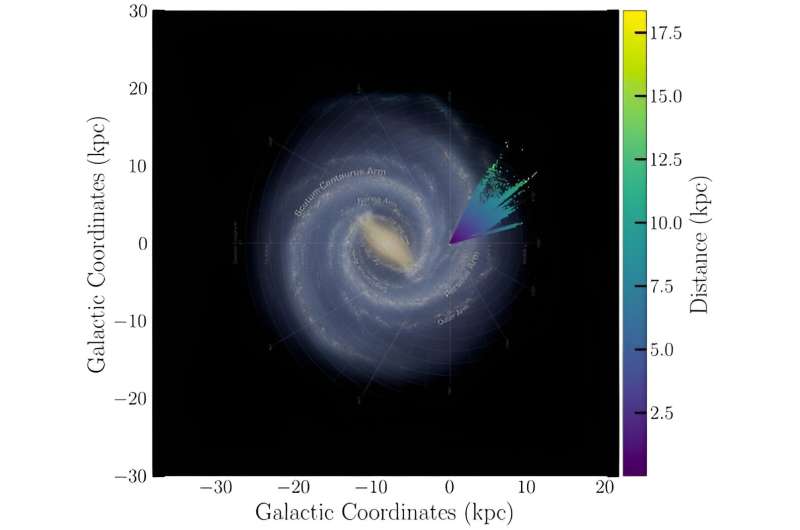This article has been reviewed according to Science X's editorial process and policies. Editors have highlighted the following attributes while ensuring the content's credibility:
fact-checked
peer-reviewed publication
trusted source
proofread
SETI works best when telescopes double-check each other

The Search for Extraterrestrial Intelligence (SETI) has evolved considerably in the past 60 years since the first experiment was conducted. This was Project Ozma, which was conducted in 1960 by Dr. Frank Drake and his colleagues using the National Radio Astronomy Observatory (NRAO) in Green Bank, West Virginia. While the experiment did not reveal any radio signals from space, it established the foundation upon which all future SETI is based. Like Ozma, the vast majority of these experiments have searched for possible technosignatures in the radio spectrum.
Unfortunately, this search has always been plagued by the problem of radio interference from Earth-based radio antennas and satellites in orbit, which can potentially flood SETI surveys with false positives. In a recent study published in The Astronomical Journal, an international team of astronomers (including researchers with Breakthrough Listen) recommended that future technosignature searches rely on multi-site simultaneous observations. This has the potential of eliminating interference from terrestrial sources and narrowing the search for extraterrestrial radio signals.
The team was led by Owen A. Johnson, an astrophysicist and Ph.D. researcher at Trinity College Dublin. He was joined by researchers from Breakthrough Listen, the SETI Institute, the Max Planck Institute for Radio Astronomy, the European Southern Observatory (ESO), the Mullard Space Science Laboratory (MSSL), and multiple universities in Ireland, Sweden, and France. They were joined by Dr. Simon Pete Worden, the former director of NASA's Ames Research Center and the present Chairman of the Breakthrough Prize Foundation, Breakthrough Initiatives.
To date, the most ambitious and comprehensive search for extraterrestrial intelligence (SETI) and their associated technosignatures is Breakthrough Listen. Launched in 2016, this ten-year survey will examine the over 1,000,000 stars closest to Earth, the center of our galaxy, the entire galactic plane, and the 100 closest galaxies to ours. This experiment is mainly concerned with radio technosignatures, covering five times more of the radio spectrum than previous experiments, but is also on the lookout for optical laser transmissions.
Previous SETI experiments have been primarily constrained by sensitivity and scope, typically confined to searches between 1 and GHz, placing them in the Ultra-High Frequency (UHF) and low-microwave range. Meanwhile, the low-frequency radio band has remained largely unexplored, mainly because of the prodigious amounts of radio interference from galactic sources that create a lot of background noise. However, as Johnson told Universe Today via email, advancements have been made over time that have significantly improved the sensitivity of astronomers' equipment:
"For instance, comparing instruments like JWST to Spitzer or newer radio arrays like Meerkat to older ones (85 footers) at the Green Bank Telescope, we observe substantial progress. Presently, we are far more sensitive than we were in the 1960s when these studies began. We can now cover larger portions of the sky, thanks to programs like Breakthrough, and explore more of the radio band. That's not to say that each previous SETI survey was state-of-the-art during its era.
"We're investigating a relatively uncharted part of the spectrum and doing so with a broad field of view. Additionally, we employ two sites to cross-reference detected signals. The concept behind this approach is that if you were to call me while I'm standing next to the telescope in Ireland, it shouldn't register in Sweden and vice versa. This method has proven effective in eliminating false positives. However, it can only be executed if you have identical telescopes at a significant distance apart, on the order of several hundred kilometers."
For this survey, the team conducted simultaneous observations of 1,631,198 targets identified by NASA's Transiting Exoplanet Survey Satellite (TESS) and the ESA's Gaia Observatory in the Milky Way. These targets were monitored in the 110–190 MHz range using the Netherlands Institute for Radio Astronomy (ASTRON) Low-Frequency Array (LOFAR) stations in Ireland and Sweden. Said Johnson, the simultaneous nature of their observations allowed the team to search the more than 1.6 million stars in our local galaxy and were confident about the results obtained:
"We were able to rule out the presence of Doppler-drifting narrowband signals from these stars, with an equivalent isotropic radiated power of 1017 watts, for approximately 0.4 million (or 1.3 million) stellar systems at either 110 or 190 MHz. Furthermore, we encountered no false positives from using both sites. This allowed us to establish stringent constraints on civilizations transmitting at these energies and frequencies within our local galaxy."
Again, the search found no evidence of transmission technologies coming from these locations (at least, not at the frequencies specified during the survey). However, the results demonstrate how simultaneous observations can eliminate uncertainty when conducting searches for technosignatures, which could have significant implications for radio SETI. In effect, it demonstrates that a previously unexplored part of the radio spectrum (low-frequency) can be surveyed without interference, creating opportunities for more robust surveys in the future.
"It has shown that future studies need to increase either the number of targeted searches or sensitivity by an order of magnitude," said Johnson. "I plan to conduct a Low-Frequency Pulsar, Fast Radio Burst (FRB), and Technosignature search with LOFAR in the coming year. This involves pointing the telescopes at zenith, where they are most sensitive, for a few hours each week for a year. Through this effort, we aim to further refine the technosignature parameter space at this frequency and, hopefully, make exciting discoveries of exotic transients along the way."
More information: Owen A. Johnson et al, A Simultaneous Dual-site Technosignature Search Using International LOFAR Stations, The Astronomical Journal (2023). DOI: 10.3847/1538-3881/acf9f5. On arXiv: DOI: 10.48550/arxiv.2310.15704
Journal information: Astronomical Journal , arXiv
Provided by Universe Today





















